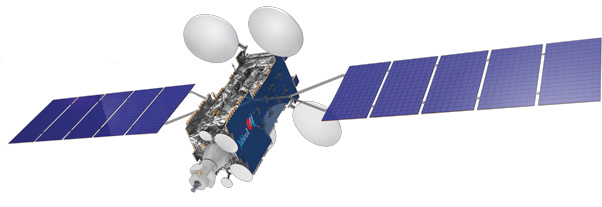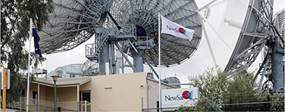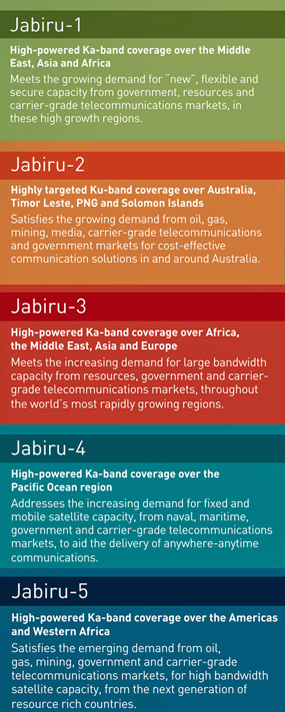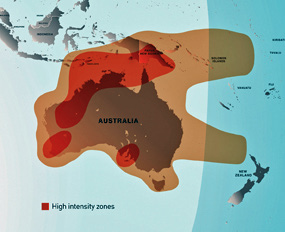Scott Sprague has more than 30 years senior management experience in the satellite and telecommunications sectors. With responsibilities spanning global sales, marketing, operations and customer service, Scott has held senior positions at KPNQwest, Infonet Service Corporation and AT&T, before moving into the satellite sector as Senior Vice President of Global Sales for SES. At SES, Scott was responsible for leading sales teams and growing global revenues across media, enterprise and government verticals around the world.

Scott holds an Executive MBA in International Business from Western International University and a BS degree in Business Administration from Illinois State University. Most recently, Scott was based in Hong Kong as the Chief Operating Officer of Asia Broadcasting Satellite (ABS). Here Scott was responsible for managing the global sales, marketing, technical support and operations of value-added services.
Relocating from Chicago, USA, Scott joined NewSat in Australia in June 2013. With his extensive satellite knowledge, leadership and management experience, Scott will be a key contributor to NewSat’s future growth. Scott’s proven track record leading global satellite sales, marketing and customer service will drive new business and market share, while greatly assisting NewSat as the company transforms into a global satellite operator.
SatMagazine (SM)
Mr. Sprague, would you tell the readers about your background and what lead you to a career in the satellite industry?
Scott Sprague
I have held senior positions at KPNQwest, Infonet Service Corporation and AT&T, before moving into the satellite sector as Senior Vice President of Global Sales for New Skies/SES. At New Skies/SES, I was responsible for leading sales teams and growing global revenues across media, enterprise and government verticals around the world.
More recently, I was based in Hong Kong as the Chief Operating Officer of Asia Broadcasting Satellite (ABS). I was responsible for managing the global sales, marketing, technical support and operations of value-added services.

SM
You recently joined NewSat—what prompted your decision?
Scott Sprague
I have known the NewSat team for more than 10 years. Initially when New Skies sold NewSat the Adelaide and Perth teleport facilities, and then as a customer for capacity over the Middle East and Asia Pacific.
SM
From the experience derived from your most recent decision making roles, what do you hope to bring to NewSat?
Scott Sprague
With my extensive satellite knowledge and strategic management experience, I hope to greatly assist NewSat’s next phase of growth and future business success. With recognized capabilities to lead global satellite sales, marketing and customer service, I intend to drive new business, increase the company’s market share, and support NewSat’s transformation from a teleport operator into that of a global satellite operator. I am also keenly aware of the need to support our customers. My main goal will be to sustain and enhance the already strong “customer first” approach that NewSat brings to the market.
SM
What are your thoughts regarding the satellite communications industry in Australasia? What new programs can APAC expect from your firm over the next few quarters?

NewSat’s Perth teleport. Photo courtesy of NewSat.
Scott Sprague
I believe the recent CommunicAsia 2013 truly highlighted Asia’s focus. The region must drive sustainable growth in an already crowded sky; the need to innovate; increasing customer demand for capacity; and offset the ever diminishing spectrum. The emerging economies with growing middle class incomes are also demanding capacity, due to heavy bandwidth mobile applications and ever-increasing broadband system requirements.
NewSat has a matched focus on mobility, heavy bandwidth application requirements, Ka-band and meeting demand efficiently, as Asia-Pacific becomes more and more competitive with the markets in China, India and Indonesia continuing to grow.
We are definitely excited about the launch of Jabiru-2 in late 2013. This satellite will provide fresh capacity over Australia, Timor Leste, Papua New Guinea and the Solomon Islands. With more capacity, we will be able to provide for greater mobile resource exploration as well as be able to meet larger bandwidth application requirements. We will also be more effective in supporting the ongoing operations of enterprise and government in the Australasia region.
SM
2013 has been quite an exciting year for NewSat so far—can you tell us a bit about what has been happening?

Jabiru satellite program global coverage plans
Scott Sprague
It has, indeed, been an exciting year and a great time to be with NewSat. In example, the US Ex-Im Bank and COFACE finalized US$611 million in funding commitments for Jabiru-1, the launch of Jabiru-2, as well as the continued success of the base teleport business and the plan for future Jabiru satellites.
NewSat is growing at a rapid rate. We are reiterating our customer focus; expanding into new regions where demand is growing; listening and nurturing our loyal customer base; and also looking at ways to help new customers with their communications requirements and, in turn, their business successes.
SM
Australia’s first commercial Ka-band satellite, Jabiru-1, is currently under construction. How is this project progressing? What does the launch schedule look like, as of this writing?
Scott Sprague
Jabiru-1 construction continues with satellite manufacturer, Lockheed Martin, after successful completion of their Preliminary Design Review (PDR) last year. The resident Jabiru engineering team in Newtown Pennsylvania, USA, along with NewSat CTO, David Ball and Lockheed Martin, recently completed a series of technical interchange meetings regarding key satellite subsystems. The meetings demonstrated excellent progress. Construction continues on schedule for satellite delivery and launch in 2015. Critical Design Review (CDR) remains on schedule to be concluded before the end of 2013.
SM
You also have the launch of Jabiru-2 quite close at hand; can you tell us more about this satellite? Why is Jabiru-2 so important to your company and to potential users?
Scott Sprague
Jabiru-2 will provide “new” Ku-band capacity across Australia, Timor Leste, Papua New Guinea and the Solomon Islands. Supplying hot zones over the Pilbara, the Kimberley, Western Australia’s North West Shelf, Timor Gap, Timor Leste and Papua New Guinea, Jabiru-2 will satisfy the growing demand for high bandwidth connectivity and cost-effective communications for oil, gas, mining, media, carrier-grade telecommunications and government sectors.
Jabiru-2 further strengthens NewSat’s position as the leading satellite communications company servicing the mining and exploration sector and we are excited as the satellite will provide fresh capacity over Australia.
Jabiru-2 is scheduled to launch in 2014 and will further enhance the profitability and growth of NewSat’s base teleport business. Providing for mobile exploration and larger bandwidth application requirements, Jabiru-2 will help to support the ongoing operational efficiency of the Australian mining and oil and gas sectors.
SM
NewSat has a solid teleport business; can you tell us a bit more about this NewSat business?
Scott Sprague
NewSat won a number of significant projects to provide satellite communications to oil, gas, mining, construction, maritime, aeronautical and government markets, across Australia, Asia and the Middle East this year. New contracts represent a growth rate of 28 percent when compared to the same period last year and are incremental to NewSat’s existing contract base.
NewSat continues to achieve excellent customer retention rates due to its high levels of service and support, culminating in over 99.99 percent teleport up-time. The contract with BAE Systems to provide satellite communications for the Wheatstone Project, one of the world’s largest LNG projects located in the North Western region of Western Australia, was a major achievement for NewSat.
Our teleports continue to reinforce their global reputation for engineering excellence, with fifth place ranking in the global “Fast Twenty” of 2012 and also featured tenth in the Independent “Top Twenty” of 2012. NewSat was also awarded Top 3 Finalist for “Satellite Provider of the Year” in the ACOMM Awards, a collaboration of Communications Alliance and Communications Day, recognizing excellence in Australian telecommunications.
We have also recently acquired land that is adjacent to our Adelaide teleport. This doubles our size and presence in South Australia. This facility expansion will include a number of large antennas, the Jabiru satellite control facility and Jabiru customer support center, upgraded power systems and generators, as well as other enhancements to security and equipment, which are essential for providing services to defence.
SM
What are your thoughts regarding hosted payloads? Given NewSat’s recent appointed of Mr. Don Brown as a Senior V.P. of Strategic Planning, with his previous position being that of V.P. of Hosted Payloads at Intelsat, can we envision a leading role by your company in this area? How will such be implemented?

Jabiru-2 will deliver 216 MHz of capacity, providing highly focused Ku-band coverage, to satisfy the demanding communication requirements for resource projects in and around Australia.
Scott Sprague
As Senior Vice President of Strategic Planning, Don will lead NewSat’s strategy and long-term priorities, from strategy formulation and market intelligence, to business case creation and financial analysis, through to the execution of complex cross-functional and cross-region projects. In this newly formed strategic role, Don will provide leadership and expertise across hosted payloads and government markets to support NewSat’s continued growth and expansion.
SM
Another area of great concern throughout the industry is interference—how does, or will, NewSat work to counter these communication threats?
Scott Sprague
NewSat is committed to working with other satellite operators on this most important issue. As an industry, it is crucial we do everything possible to ensure we can provide the highest quality service possible to our customers—this means we must deter and eliminate interference interruptions to service.
SM
The hiring of properly trained professionals to lead and work on crucial projects is being somewhat hampered due to educational systems not properly preparing students for roles in the satellite and space industries. How can the industry, and NewSat in particular, assist middle and high schools and colleges to bring more STEM coursework into their programs? How can the industry encourage career paths within our various market segments?
Scott Sprague
NewSat’s senior management, including Chief Technology Officer, David Ball and myself, are actively involved as thought leaders in the satellite industry, contributing to other university programs, industry groups and leadership panels. We need to inject the excitement of space back on the agenda for mainstream media, here in Australia.
Being involved in programs such as the Southern Hemisphere Summer Space Program that NewSat participated in earlier this year asserts NewSat’s commitment to addressing an area of concern for the satellite industry. In general, there is a world-wide shortage of trained professionals and with the industry growing at an astounding pace, satellite and space companies are finding it more and more difficult to find appropriate candidates to fill critical seats throughout all divisions of work. NewSat is committed to assisting in this regard and believes that programs such as the program run by the University of South Australia and International Space University are excellent platforms for those interested in pursuing careers within the space and telecommunications industries.
NewSat is also actively involved, and presented at, the Australian Space Development Conference, Aerospace Futures and Australian Youth Aerospace Association Careers Evening in Victoria. We need to focus on developing a student’s skill and capabilities from the bottom-up to ensure the continued drive for professional technology development in various market segments as well as the motivation to be at the forefront of space innovation.
SM
You have more than 30 years’ experience in the satellite and telecommunications industry, including senior management roles at SES and ABS. What have you observed as the biggest challenges and opportunities the satellite industry has faced so far?
Scott Sprague
The biggest challenge is for the satellite industry to stay aligned with customer needs. We need to be flexible and responsive when supporting our clients. This is on the technical and commercial side of the business. Our customers’ business models are changing and we need to change with them. The old way of thinking and the old business models no longer work when supporting our clients on a global basis. If we don’t continually change, we will be displaced by other communication technologies.
SM
When you look back at your career, what project or projects truly bring a sense of satisfaction to you?
Scott Sprague
There is not a specific project that I would point out. However, rather being part of a team that over a short period of time evolved into one of the most customer focused organizations in the satellite sector. I am confident that the customers of New Skies would echo my feelings. As I move forward with my new role at NewSat, I do so with the conviction that all of the NewSat employees will also place our customers where they deserve to be — first.
About NewSat
NewSat will be expanding its satellite capabilities with the Jabiru Satellite Program, starting with the launch and operation of Jabiru-1, Australia’s first commercial Ka-band satellite. Jabiru-1, a large next generation satellite, will provide superior coverage over South East Asia, the Middle East and North Africa. Jabiru-2, also scheduled, will deliver enhanced coverage over Australia, Timor Leste and Papua New Guinea. NewSat has rights to eight premium orbital slots and its fleet of next generation geostationary satellites will lead Australia’s space quest. For more information, please visit www.newsat.com.

